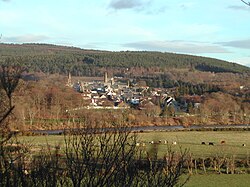Fochabers: Difference between revisions
Created page with '{{Infobox town |name=Fochabers |gaelic=Fachabair or Fothabair |county=Morayshire |picture=Fochabers and the Spey.JPG |picture caption=Fochabers village, beside the River Spey |os…' |
No edit summary |
||
| Line 15: | Line 15: | ||
|constituency=Moray | |constituency=Moray | ||
}} | }} | ||
'''Fochabers''' is a village in the Parish of Bellie, in [[Morayshire]], standing on the east bank of the [[River Spey]]. Fochabers is found not far from the county town, [[Elgin]]. | '''Fochabers''' is a village in the Parish of [[Bellie]], in [[Morayshire]], standing on the east bank of the [[River Spey]]. Fochabers is found not far from the county town, [[Elgin]]. | ||
It is a | It is a sizeable village of around 2,000 people, which enjoys a rich musical and cultural history. | ||
The village's name may be from Gaelic 'feith' meaning a bog and 'aber' meaning 'river-mouth'. It is pronounced ''FO-ha-brz'' with the accent on the first syllable; the 'o' is pronounced as in 'got'. | The village's name may be from Gaelic 'feith' meaning a bog and 'aber' meaning 'river-mouth'. It is pronounced ''FO-ha-brz'' with the accent on the first syllable; the 'o' is pronounced as in 'got'. | ||
| Line 25: | Line 25: | ||
There are two schools in Fochabers, Milne's Primary School (formerly Milne's Institution) and Milne's High School, which currently serves approximately 600 pupils from Fochabers itself and the surrounding villages. Milne's Institution was originally built in accordance with Alexander Milne's Last Will and Testament, using money he left for this purpose. | There are two schools in Fochabers, Milne's Primary School (formerly Milne's Institution) and Milne's High School, which currently serves approximately 600 pupils from Fochabers itself and the surrounding villages. Milne's Institution was originally built in accordance with Alexander Milne's Last Will and Testament, using money he left for this purpose. | ||
For nearly three decades, the people of Fochabers campaigned for a bypass, as the village is situated on the A96, the only direct route from [[Aberdeen]] to [[Inverness]], and consequently | For nearly three decades, the people of Fochabers campaigned for a bypass, as the village is situated on the A96, the only direct route from [[Aberdeen]] to [[Inverness]], and consequently suffered from serious traffic problems. Construction work on a bypass for Fochabers and the neighbouring village of [[Mosstodloch]] started on 2 February 2010 and was completed in Spring 2012, at a cost of £31.5 million.<ref>{{cite news|url=http://news.bbc.co.uk/1/hi/scotland/north_east/8492040.stm|title=Fochabers bypass work gets under way|publisher=BBC News|date=2 February 2010|accessdate=25 April 2011}}</ref> The project was significantly delayed due to conflict regarding the proposed route, and discovery of a Neolithic settlement on the site of the bypass. | ||
==Outside links== | ==Outside links== | ||
Revision as of 10:32, 22 June 2015
| Fochabers Gaelic: Fachabair or Fothabair | |
| Morayshire | |
|---|---|
 Fochabers village, beside the River Spey | |
| Location | |
| Grid reference: | NJ345585 |
| Location: | 57°36’44"N, 3°5’50"W |
| Data | |
| Population: | 1,499 |
| Post town: | Fochabers |
| Postcode: | IV32 |
| Dialling code: | 01343 |
| Local Government | |
| Council: | Moray |
| Parliamentary constituency: |
Moray |
Fochabers is a village in the Parish of Bellie, in Morayshire, standing on the east bank of the River Spey. Fochabers is found not far from the county town, Elgin.
It is a sizeable village of around 2,000 people, which enjoys a rich musical and cultural history.
The village's name may be from Gaelic 'feith' meaning a bog and 'aber' meaning 'river-mouth'. It is pronounced FO-ha-brz with the accent on the first syllable; the 'o' is pronounced as in 'got'.
The village owes its existence to Alexander Gordon, 4th Duke of Gordon (1743–1827). It was, like several villages found across Scotland, a foundation of the Scottish Enlightenment of the late eighteenth century. Such Enlightenment villages, founded by keen lairds, are characterised by straight, wide streets in mainly rectangular layouts, a central square, and the houses built with their main elevations parallel to the street. The tenants benefited from more spacious homes, and the Duke, it has to be said, benefited from not having his poorer tenants living in hovels right on the doorstep of Gordon Castle. Fochabers was founded in 1776, and is one of the best examples of a planned village. It is a conservation area, with most of the buildings in the High Street listed as being of historical or architectural interest.
There are two schools in Fochabers, Milne's Primary School (formerly Milne's Institution) and Milne's High School, which currently serves approximately 600 pupils from Fochabers itself and the surrounding villages. Milne's Institution was originally built in accordance with Alexander Milne's Last Will and Testament, using money he left for this purpose.
For nearly three decades, the people of Fochabers campaigned for a bypass, as the village is situated on the A96, the only direct route from Aberdeen to Inverness, and consequently suffered from serious traffic problems. Construction work on a bypass for Fochabers and the neighbouring village of Mosstodloch started on 2 February 2010 and was completed in Spring 2012, at a cost of £31.5 million.[1] The project was significantly delayed due to conflict regarding the proposed route, and discovery of a Neolithic settlement on the site of the bypass.
Outside links
References
- ↑ "Fochabers bypass work gets under way". BBC News. 2 February 2010. http://news.bbc.co.uk/1/hi/scotland/north_east/8492040.stm. Retrieved 25 April 2011.